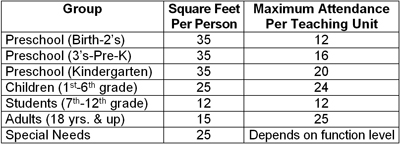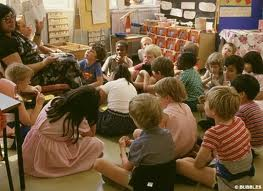The kind and quality of space for a class or department has a significant impact on overall success of the class. At a minimum space should be clean, attractive and large enough for the current attendance plus a few guests. Age-appropriate furniture and equipment should be in the room depending on the classes or departments using the space. The following chart provides some basic guidelines for the amount of space needed per person by groups:
Access to space is another important concern. Parents with preschoolers and older adult need the space to be convenient to parking, with ground level access.
Adult and student rooms are best painted in soft, neutral colors with a color accent wall or trim. Carpet is the preferred floor covering. The room needs a focal wall with a whiteboard or chalkboard, as well as, chairs for participants and table(s) if there is adequate space. The focal wall needs open space for posters. There should be a cabinet or open shelf for basic supplies. It is a good idea to have a few extra Bibles in the room.
Preschool and children’s rooms are best painted in soft, neutral colors with a color accent wall or trim. The furniture should be age-appropriate. There should be a focal wall or bulletin board for displays with the exception of younger preschoolers. Preschool rooms are set up by activity areas with the exception of babies and 1’s. Preschool rooms need a water source and restroom in the room or nearby. The preferred floor covering is carpet with the exception of vinyl floors for babies-1’s.
 Caring for preschoolers includes providing a clean environment where the child can explore, create, learn and play. That means toys, teaching materials, equipment, walls and floors need to be clean and ready for the child. It is important to be aware of cleaning procedures and hygiene practices to ensure a safe and clean environment for the child. For recommended hygiene practices visit http://www.lifeway.com/Article/childhood-ministry-basics.
Caring for preschoolers includes providing a clean environment where the child can explore, create, learn and play. That means toys, teaching materials, equipment, walls and floors need to be clean and ready for the child. It is important to be aware of cleaning procedures and hygiene practices to ensure a safe and clean environment for the child. For recommended hygiene practices visit http://www.lifeway.com/Article/childhood-ministry-basics.
In conclusion, I want to share some common shortfalls I find when consulting with churches. Entrances and doors are not clearly marked. Today, it is highly important to have a visible registration/check-in process for preschoolers. Preschool rooms often have too many and inappropriate toys (they can produce
a safety hazard or might be unrelated to teaching). It is common to find outdated displays and posters on walls and bulletin boards. I find furniture with sharp edges or broken tables and chairs still in use. Often, I find rooms filled with lots of equipment and other items unrelated to its use(s). Learn to think like a guest; look around your room to see if anything would catch a guest’s attention. When we are expecting guests at home we clean house. Why don’t we do that at church? Maybe we are not expecting guests?
_______________________________________
Tom Belew has served as Small Groups and Childhood Specialist for the California Southern Baptist Convention since 2002. He previously served as Minister of Education in churches in Arizona and California.




